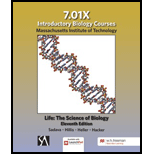
To review:
The events took place inside the body of a female koala and the possible cause of ovulation that could be removed through the given experiment.
Introduction:
In most of the female mammals, including humans, the ovulation takes place in a cyclical pattern. These females ovulate spontaneously and require no stimulus from outside to release their eggs. On the other hand, there are certain female mammals that require external stimulus to release their eggs and are called as reflex ovulators. Reflex ovulators include female mammals, such as rabbit, koala, and camels, and they ovulate only after copulation.
It is already given:
Experiment: The following two groups, each including four female koalas, were formed.
Group A: Pairing and mating of females with males on the 2nd day of the estrus cycle.
Group B: Shifting of koala females next to males without any physical contact.
The blood samples from both the groups provided the following results:
Group A: 25 ng/mL (nanogram per milliliter) of LH during the duration of 24 to 32 hours after mating and birth of baby koalas after 35 days postcoitus.
Group B: No change in the levels of LH hormone and no birth of any baby koala.
Explanation of Solution
In humans, the ovulation cycle takes place after every 24 to 28 days in a cyclical fashion. The eggs are released whether mating has taken place or not. Mammals, such as koalas, enter into the estrus cycle but do not release their eggs until the mating has taken place. The luteinizing hormone is released only during ovulation; hence, in the given experiment, LH is taken as an indicator.
In a female koala, the mating provides an external stimulus, which leads to the release of LH. The mature follicles get triggered by LH and the eggs get released. Mating provides the sperms from a male, which fertilize the eggs as a result of which female koalas give birth, 35 days after the mating.
Thus, it can be concluded that the female koalas produce LH and release their eggs only when the external stimuli, which is mating with the male, is provided. Contact with the male could be removed from the given experiment to avoid ovulation.
Want to see more full solutions like this?
Chapter 42 Solutions
LIFE:SCIENCE OF BIOL.(LL) >CUSTOM<
- multiple births are observed commonly in women treated for infertility with drugs that stimulate the release of gonadotropic hormones. what could be the reason?arrow_forwardMammalian sperm don’t live very long after ejaculation.Therefore, for a rhino cow to become pregnant, the sperm must be placed in her vagina or uterus, whether by mating or by artificial insemination, at about the same time that ovulation occurs.The simplest way to ensure correct timing is to induce ovulation and have mating or artificial insemination the same day. How might ovulation be induced, in rhinos or in other mammals?arrow_forwardWhich of the following statement does NOT describe the role of luteinizing hormones (LH) in the female reproductive system? Select one: A. Causes the release of mature ovum from the ovary B. Suppress the production of estrogen C. Stimulate the production of progesterone D. Stimulate the development of the corpus luteumarrow_forward
- In humans, one primary spermatocyte yields _____ sperm and _____ polar body(ies), while one primary oocyte yields _____ oocyte(s) and _____ polar body(ies). 1; 2; 1; 2 1; 2; 4; 0 4; 0; 1; 2 4; 0; 4: 0 2; 2; 2; 2arrow_forwardTrace the flow of sperm from formation to eventual release from a male cat. Use number 1 as the point of originarrow_forward. This experiment is an example of a research approach in which scientists infer how something works normally based on what happens when the normal process is blocked. What normal process was blocked in Jost’s experiment? From the results, what inference can you make about the role of the gonads in controlling the development of mammalian genitalia?arrow_forward
- In creating male contraceptives, what steps in fertilization might be possible to block to produce contraceptives in males?arrow_forwardAfter learning about the reproductive systems, how would advise a couple with following concern: "If we do not want a baby for next two years, how can we calculate the safe sex period?" She shares that her cycle is regular but not standard 28 days long cycle (so the standard explanation form different sources won't work unless you think critically)! At what time of the female cycle is she most likely to prevent fertilization of her ovulated egg? Consider the fact that her cycle is not 28 days but longer or shorter (you pick). Do males have any time (in their cycle- if any) when their gametes would not be able to fertilize the egg? In other words when can intercourse lead to least chance of pregnancy? Feel free to check with your older friends, doctors, nurses, or anyone who you feel comfortable talking about this.arrow_forward. Describe the pre- and post- ovulation events of the menstrual cycle. How is menstruation prevented if pregnancyoccurs?arrow_forward
- The average sperm count in males is now lower than it was several decades ago. The reasons for the lower sperm count usually seen today are not known. What data might be helpful in order to formulate a testable hypothesis?arrow_forwardWhich of the following statements does NOT describe the role of luteinizing hormone (LH) in the female reproductive system? a. Stimulates the production of progesterone b. Stimulates the development of the corpus luteum c. Suppresses the production of estrogen d. Causes the release of mature ovum from ovaryarrow_forwardWhich of the following statements does NOT describe the role of progesterone in the female reproductive system? a. Triggers the release of the ovum b. Prevents smooth muscle contraction, thereby preventing premature birth c. Prevents the shedding of the endometrium d. Ensures that the endometrium is thick enough to support a fetilized eggarrow_forward
 Human Heredity: Principles and Issues (MindTap Co...BiologyISBN:9781305251052Author:Michael CummingsPublisher:Cengage Learning
Human Heredity: Principles and Issues (MindTap Co...BiologyISBN:9781305251052Author:Michael CummingsPublisher:Cengage Learning


